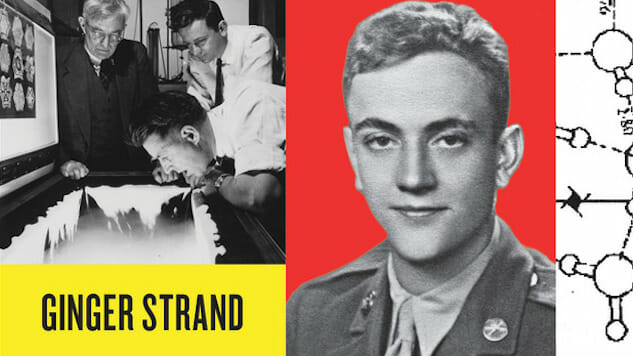The Brothers Vonnegut: Science and Fiction in the House of Magic by Ginger Strand

“Science is magic that works.” ?? Kurt Vonnegut, Cat’s Cradle
As an avid Kurt Vonnegut fan, I’m advising you of two things: First, do not open this book anticipating a typical biography of the Cat’s Cradle and Slaughterhouse-Five author. Second, open this book.
 For a long time, Cat’s Cradle was not only my favorite among Vonnegut’s books, but my favorite book. While Slaughterhouse is typically readers’ first introduction to the sweetly sardonic humanist and Breakfast of Champions wins the most fans, 1963’s Cat’s Cradle best portrayed mankind’s potential for worldwide catastrophe in the pursuit of technological advancements.
For a long time, Cat’s Cradle was not only my favorite among Vonnegut’s books, but my favorite book. While Slaughterhouse is typically readers’ first introduction to the sweetly sardonic humanist and Breakfast of Champions wins the most fans, 1963’s Cat’s Cradle best portrayed mankind’s potential for worldwide catastrophe in the pursuit of technological advancements.
Ginger Strand’s dual biography invites another Vonnegut—the lesser famous, yet though no less remarkable Bernard—to share the spotlight as she provides an intimate account of this country’s substantially swift advancements in science and industry following World War II.
Kurt might’ve been the man of letters, but his brother Bernard was the man of science; the former started out writing for newspapers while the latter received his Ph.D in chemistry from MIT and published his undergraduate chemistry thesis on X-ray analysis of crystalline bromine. Now, if I haven’t lost any of you English majors at this point, it would likely interest you to know that Bernard’s work at General Electric on cutting edge weather-control technologies would have considerable influence on Vonnegut’s apocalyptic parable we now know as Cat’s Cradle.
We all know how dry non-fiction writing has the potential to be, but Strand cinches a novelist’s knack for edge-of-the-seat narration (much like Eric Larson or Jon Krakauer,) rewarding curious readers with a breathtaking portrayal of Kurt’s capture at the hands of the Nazis in 1944 after the firebombing of Dresden. The fateful fog that rolled up and surrounded Kurt and his fellow infantrymen that autumn towards the end of the war is utilized by Strand as an effective metaphor to match the clouds that Bernard would soon be “seeding” through “Project Cirrus.”
-

-

-

-

-

-

-

-

-

-

-

-

-

-

-

-

-

-

-

-

-

-

-

-

-

-

-

-

-

-

-

-

-

-

-

-

-

-

-

-








































